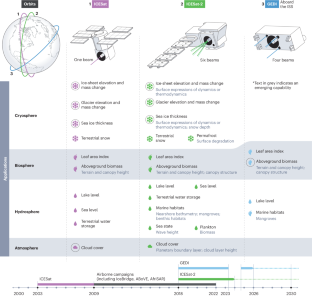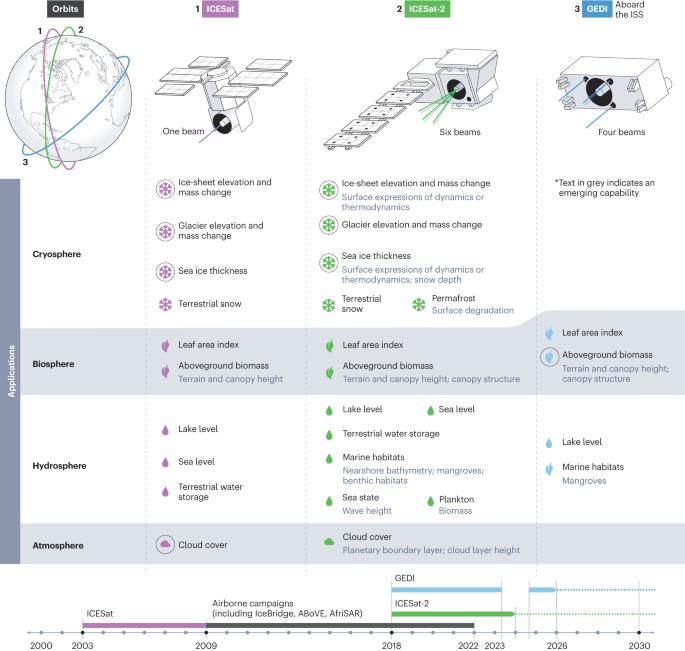Monitoring Earth’s climate variables with satellite laser altimetry
引用次数: 0
Abstract
Satellite laser altimetry measures accurate elevations of the Earth’s surface and precise changes with time, monitoring key climate variables. These observations have transformed understanding of the Earth System, revealing changes and dynamics across spheres. In this Review, we highlight the Earth and climate science contributions from three NASA satellite laser altimeter missions: Ice, Cloud and land Elevation Satellite (ICESat; 2003–2009), ICESat-2 (2018 to present) and Global Ecosystem Dynamics Investigation (GEDI; 2018 to present). Over two decades of observations, satellite altimetry revealed cryosphere decline, including a loss of 320 Gt yr−1 in global land ice from Greenland and Antarctica, and a 30% decrease in volume of winter sea ice in the Arctic between 2003 and 2021. Observations have also been key to understanding ecosystems on land, providing data on the hydrosphere (showing that 57% of the Earth’s seasonal terrestrial water storage variability comes from human-managed reservoirs) and biosphere (showing that forest carbon stocks have globally increased owing to growth, despite a loss of the equivalent of ~8 Gt CO2 from land use). In the atmosphere, the data have enabled assessment of the global vertical cloud distribution, aerosol fraction, and dust and smoke transport. There is currently no planned satellite laser altimeter mission to continue from ICESat-2 and GEDI, jeopardizing critical data collection that supports decision-making and environmental management. Three satellite laser altimeter missions (ICESat, ICESat-2 and GEDI) have been instrumental in tracking environmental change on Earth since 2003. This Review discusses the principles of these missions and their major contributions to Earth system science.


利用卫星激光测高法监测地球气候变量
卫星激光测高测量地球表面的精确海拔高度和随时间的精确变化,监测关键的气候变量。这些观测改变了人们对地球系统的认识,揭示了整个地球的变化和动态。在这篇综述中,我们将重点介绍美国宇航局三个卫星激光测高仪任务对地球和气候科学的贡献:冰、云和陆地高程卫星(ICESat;2003-2009 年)、ICESat-2(2018 年至今)和全球生态系统动力学调查(GEDI;2018 年至今)。在二十多年的观测中,卫星测高揭示了冰冻圈的衰退,包括格陵兰岛和南极洲的全球陆地冰每年损失 320 千兆吨,以及 2003 年至 2021 年期间北极冬季海冰体积减少 30%。观测也是了解陆地生态系统的关键,提供了有关水圈(表明地球上 57% 的季节性陆地储水量变化来自人类管理的水库)和生物圈(表明尽管土地使用造成相当于约 8 Gt CO2 的损失,但由于增长,全球森林碳储量有所增加)的数据。在大气层,这些数据有助于评估全球垂直云层分布、气溶胶成分以及尘埃和烟雾的迁移。目前,ICESat-2 和 GEDI 没有继续执行卫星激光测高仪任务的计划,这将危及支持决策和环境管理的重要数据收集工作。
本文章由计算机程序翻译,如有差异,请以英文原文为准。
求助全文
约1分钟内获得全文
求助全文

 求助内容:
求助内容: 应助结果提醒方式:
应助结果提醒方式:


